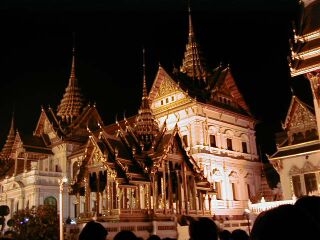
| return |
|
Cooperation with Thailand
I visited Thailand in March 1990 for the first time. This is a start of "Core University Programme" of JSPS project between the University of Tokyo and Chulalongkorn University and Princess Chulabhorn Institute. The purpose of this project is to promote cooperatively Natural Product Chemistry, Polymer Chemistry and Pharmaceutical Sciences. I was one of the member represented Hiroshima University.
The first delegate was headed by Prof. Osawa (Univ. Tokyo= Core University) and consisted of Japanese cooperative Universities (Tohoku, Toyama MP, Chiba, Hiroshima and Nagasaki). In Bangkok the future plan was discussed with Thai side (Chula = Core, Mahidol, Kohn Kaen, Silpakorn, Prince of Songkla and Chiang Mai).
The main project is exchanging scientists and to accept Thai students via Mombusho-scholarship (special category ), and to hold the seminars in Thailand in every other year. One of the agreement is the selection of the visiting scientists of Thai side would be judged by Inter Dean meeting consists of the above Thai Universities.
This project continued for 10 years and ended at 1999. The new similar project started from 2001 with Toyama Medical and Pharmaceutical University as a Japanese Core. Professor Hiroshi Watanabe is in charge of this project.
During the first period, our laboratory positively contributed the project. We received Dr. Chayan (Kohn Kaen Univ.) and Dr. Sorasak (Chiang Mai Univ.) as visiting scientists for 2 months each. Not only our lab, Prof. Yata (Pharmaceutics & Therapeutics), Prof. Masujima (Analytical Life Science) and Prof. Kihira (Department of Pharmacy, Hiroshima Univ. Hospital) accepted several scientists from Thailand. In 1995, our faculty concluded the Agreement for Collaboration with Kohn Kaen University (Signing Ceremony)
In 1996, Inter-Country Seminar on Natural Products was held in Bangkok, and Yamasaki was asked for Lecturer. In 1998 another seminar on Biochemistry was held in Hatyai, and Prof. Takano (Pharmaceutics & Therapeutics) and Prof. Ide (Cellular and Molecular Biology) were invited speaker. From 1995 to 1999, Yamasaki visited nearly once a year, and inspected Thai Medicinal Plants through field work (Loei at Middle Thail, Songkla at South Thai, Koh-Chang at South-East Thai and Mai Honsong at Northwest Thai). And we received one student, Tripetch Kanchanapoom as Monbusho-scholarship (special category for Core University Project) from Kohn Kaen University. He has studied deligently and published more than 9 papers in Phytochemistry and other Journals.
Concretely, from from Thai traditional herbal medicine, Millingtonia hortensis (Bignoniaceae), we isolated not only many phenylpropanoids, but also found a new type of alkaloid, millingtonine. Also from this plant, a simple flavonoid (hortensin) was isolated. However, the previous structure attributable to this compound was errorneus for two times even if NMR was available then. So, we corrected the simple structure to make a paper. We also isolated unnsual sulfer-containing glycosides from Thai Medicinal plant, Clinacanthus nutans (Acanthaceae).
Now we are still working on anti-diabetic, cytotoxic and/or anti-allergic constituents from Thak medicinal plants.